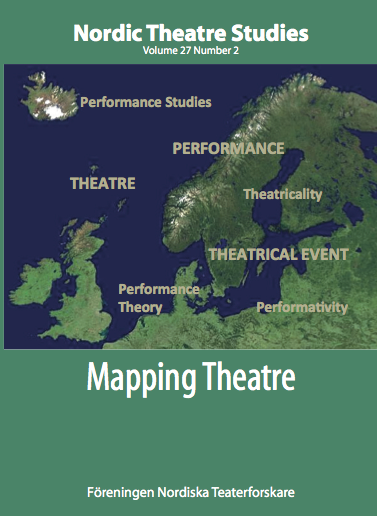Do You Feel the Same? Different Dominants of Theatrical Experience
DOI:
https://doi.org/10.7146/nts.v27i2.24248Keywords:
theatrical experience, reception research, factor analysis, exploratory research, STEP, experiential valueAbstract
The aim of this article is to present an exploratory study of reception research of theatrical experiences of general audiences of spoken theatre performances in Tartu, Estonia. The research is based on a quantitative survey of the audiences of eight spoken theatre performances. Factor analysis is used to assemble 24 different performance characteristics into five factors: Aesthetic, Entertainment, Personally Challenging, Complexity and Conventionality Factor. The factor analysis also points out some possible overlaps (characteristics that could be included into different factors at the same time) between factors, particularly between the Aesthetic and Personally Challenging Factor. These overlaps could be explained by (1) the limits of the quantitative survey, (2) the language and (3) the performances included in the survey. The overlaps, from the perspective of the viewer being inspired, challenged and excited by the performance, are due to the reason that the performances are personally touching as well as demanding and are performed by skilful performers. The article discusses the point that aesthetically challenging performances can be thematically or artistically demanding for the viewer, if the viewer has a personal relationship to the theme.References
Sabine Boerner, Johanna Jobst, “Enjoying Theatre: The Role of Visitors’ Response to the Performance” in Psychology of Aesthetics, Creativity, and the Arts, vol. 7, no. 4, 2013.
Mihaly Csikszentmihalyi, Rick E. Robinson, The Art of Seeing. An Interpretation of the Aesthetic Encounter, J. Paul Getty Museum, Getty Centre for Education in the Arts, Los Angeles 1990.
V. A. Cremona, P. Eversmann, H. Van Maanen, W. Sauter, J. Tulloch, eds.Theatrical Events. Borders, Dynamics, Frames, , Rodopi, Amsterdam, New York 2004.
Peter Eversmann, ”The Experience of the Theatrical Event” in Theatrical Events. Borders, Dynamics, Frames, V. A. Cremona, P. Eversmann, H. Van Maanen, W. Sauter, J. Tulloch, eds., Rodopi, Amsterdam, New York 2004.
Andreas Kotte, Hans Van Maanen, Anneli Saro, eds., Global Changes, Local Stages: How Theatre Functions in Smaller European Countries, Rodopi, Amsterdam, New York 2009.
Marju Lauristin, Peeter Vihalemm, “”Tõe ja õiguse” etenduse vastuvõtt ja kunstielamuse kujunemise seaduspärasused” in Tammsaare ja meie. Nõukogude Eesti raamatukogundu, XII, ENSV kultuuriministeerium ja Fr. R. Kreutzwaldi nim. ENSV riiklik raamatukogu, Tallinn 1972.
Hans Van Maanen, How to Study Art Worlds. On the Societal Functioning of Aesthetic Values, Amsterdam University Press, Amsterdam 2009.
Tim May, Social Research: Issues, Methods and Process, McGraw-Hill, Open University Press, Maidenhead, New York 2011.
Jaak Rähesoo, Estonian Theatre, Estonian Theatre Union, Tallinn 2003.
Willmar Sauter, “Who Reacts When, How and upon What: From Audience Surveys to the Theatrical Event” in Contemporary Theatre Review, vol. 12, no. 3, 2002.
Willmar Sauter, The Theatrical Event: Dynamics of Performance and Perception, University of Iowa Press, Iowa City, IA 2000.
Willmar Sauter, Eventness, a Concept of the Theatrical Event, STUTS, Stiftelsen för ut- givning av teatervetenskapliga studier, Stockholm 2008.
Piret Tali, “Kogu tõde Sofi Ost” in Eesti Päevaleht, 4 October 2010.
Rein Veidemann, “Oksaneni kuvand eestlastest on vastuoluline” in Postimees, 1 November 2010.
Marline Lisette Wilders, Hedi-Liis Toome, Maja Šorli, Attila Sazbó, Antine Zijlstra, ““I Was Utterly Mesmerised”. Audience Experiences of Different Theatre Types and Genres in Four European Cities” in Amfiteater. Journal of Performing Arts Theory, vol. 3, no. 1-2.
Downloads
Published
How to Cite
Issue
Section
License
The copyright belongs to the authors and Nordic Theatre Studies. Users can use, reuse and build upon the material published in the journal but only for non-commercial purposes. Users are allowed to link to the files, download the files, distribute the files on a local network (preferably by links), upload the files to local repositories if their institutions require them to do so, but not republish the files without proper agreements with the journal and the author.

